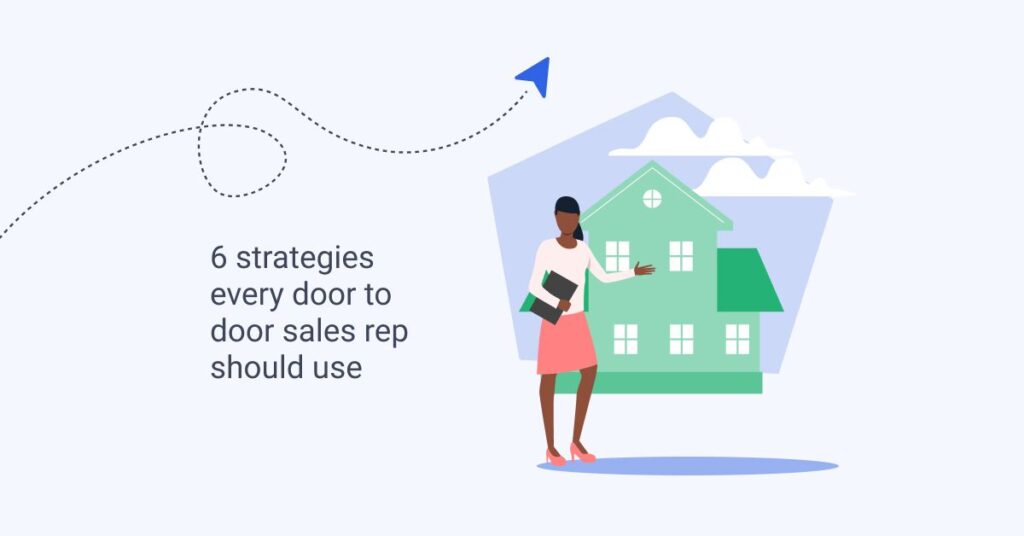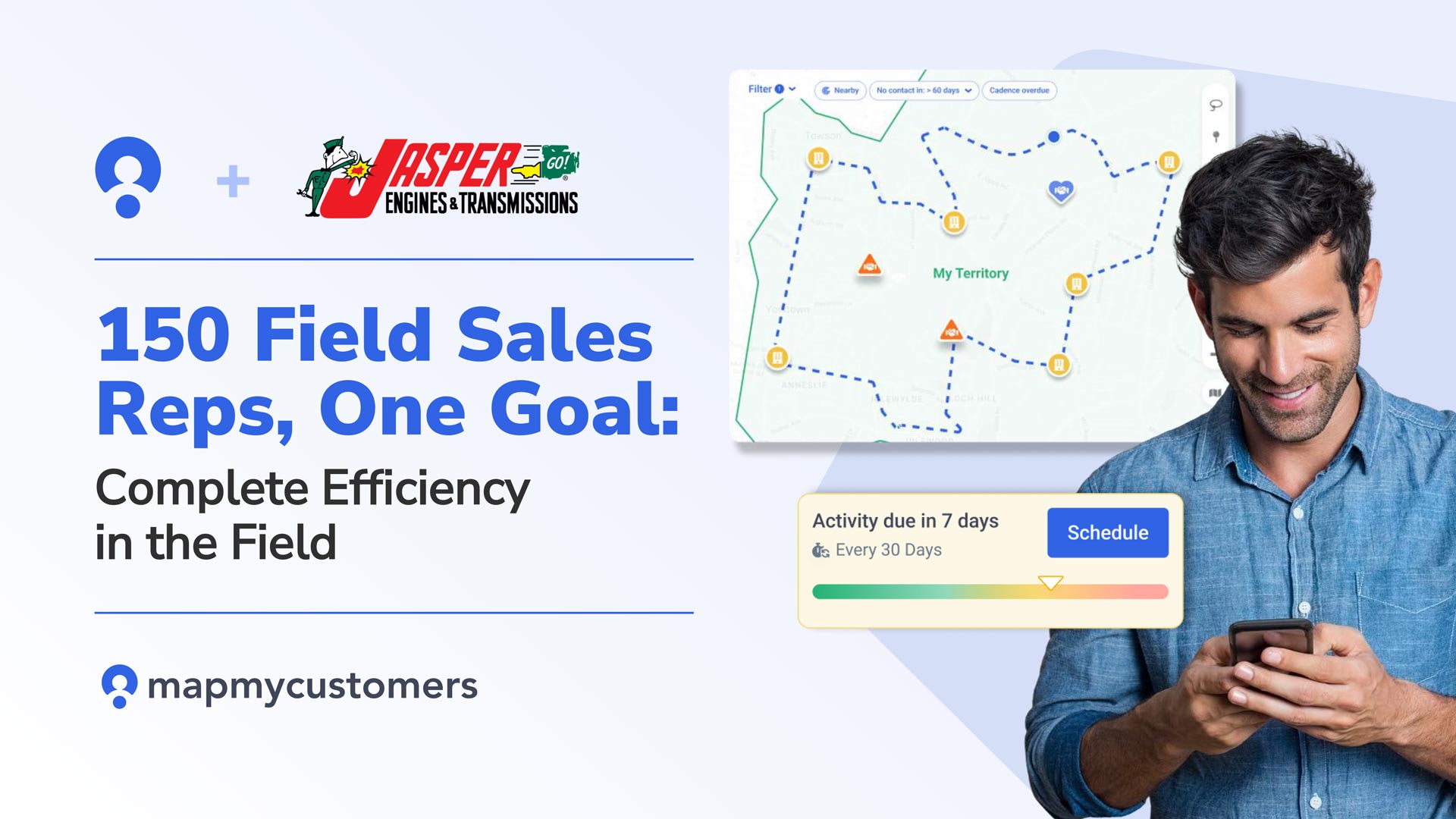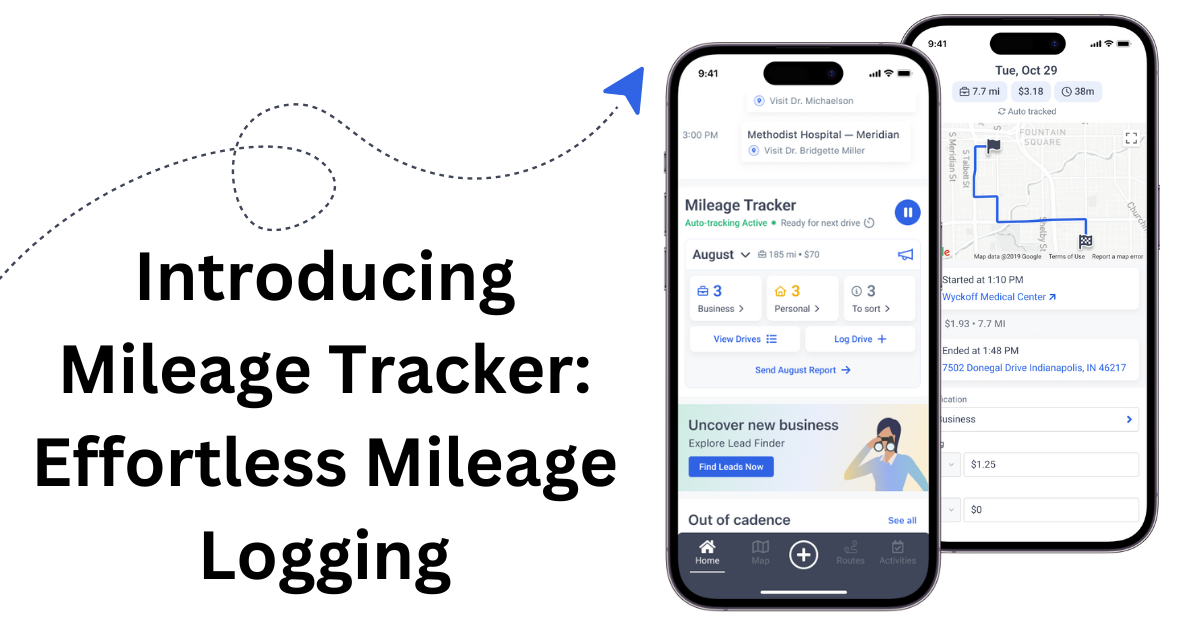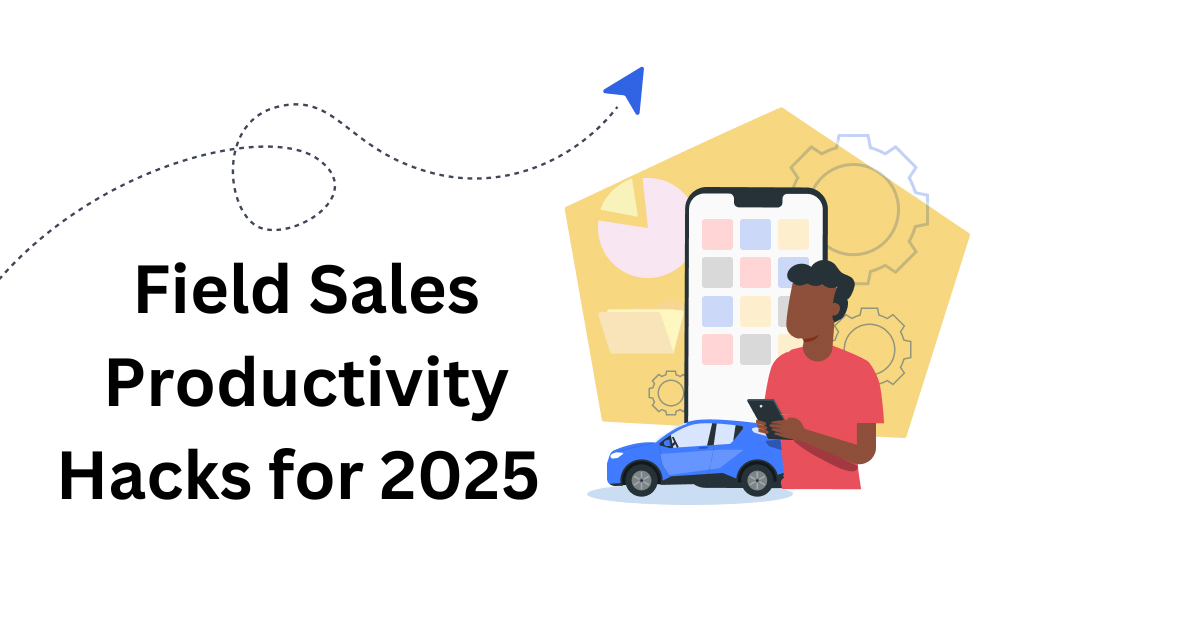
Even in 2022, there are plenty of solid reasons for salespeople to knock doors: there’s a low overhead cost, you avoid spam filters, there’s less competition, and, by meeting face-to-face, you increase brand recognition.
But door-to-door sales is one of the most infamously challenging types of selling. It takes a lot of courage to go to a stranger’s front porch. And once you get there, what do you even say? There’s nothing to hide behind—no screen, no phone, no desk.
It’s 100% up to you and your sales ability to close the deal.
Fortunately, there’s an art to door-to-door selling, and once you master it, you’ll be prepared to conquer just about any sales-challenge thrown your way. To help you, we pulled together five strategies every door-to-door salesperson should know to rack up their close rate and step up their game.
Basic Door to Door Sales Stats
If you think you might want to pursue a career in door to door sales and are curious about what you’re getting yourself into, here are some typical responsibilities:
· Morning huddle
· Drive to your location
· Door-knock
· Order entry
· Customer follow-up
· Admin work
And as far as compensation, it’s hard to nail down an average as they’re highly variable across industries and locations, but according to an Indeed survey, these salespeople earn on average a base salary of $58,155 per year. Glassdoor puts it at a base pay of $64,638 per year, but $96,873 when factoring in bonuses and commission.
The Best Door to Door Sales Industries
If you’re a homeowner, you’ve probably been confronted with door to door solar sales, door to door pest control sales, and door to door roofing sales. But with the digitization of the sales landscape (and the world in general) plus door-to-door selling getting a bad rap, do these industries and others really still do it? Yes! There are some that still do it quite successfully, even need it to be able to showcase what they’re selling. In addition to the ones already mentioned, some are:
· Cable
· Telecommunications
· Energy
· Home security
· Landscaping
Why does it work in this day and age? Door to door selling is a bit of a disruptor—in a crowded marketplace, showing up as a smiling face at someone’s door sets you apart. Unlike virtual marketing, door to door sales allows you to give demonstrations of what you’re selling, and get real-time feedback and answer questions. It can also be successful for industries selling a product or service that offers a benefit to the home itself. And it likely goes without saying that door to door sales is only used in B2C. If you’re interested in advancing from door to door to a field sales B2B career, check out this post.
Door to Door Sales Tips
Sales Tip #1: Prospect Smarter to Increase Your Odds of Success
Door-to-door sales is a form of prospecting in its own right. Back in the day, salespeople would lug their vacuum from one neighbor to the next, ring doorbells, and ask to demonstrate how much their vacuum sucked. If one sale didn’t pan out, well, onto the next door.
But thankfully, because of technology, you no longer have to throw spaghetti at the wall to see what sticks. Instead, you can prospect smarter and only go to doors where you know you have a chance at making a sale.
Build Your Ideal Customer Avatar
Prospecting for door-to-door sales is just like prospecting for any other customer. Before you can find people to target, you need to clearly identify the subset of people you want to target by building out a customer avatar (or buyer persona).

This can either take the form of a set of demographics that describes your average customer, or you can go in-detail and describe a person who you would consider the ideal customer. Both are useful strategies. Either way, here are some questions you can think about to get started:
- How old are they?
- How educated are they?
- What industry do they work in?
- What are their goals or objectives?
- What are their pain points?
- What are their biggest challenges right now?
- How do they prefer to communicate? (Email, phone, etc.)
- How do they usually gather information?
Here’s a fun free tool from Hubspot that lets you build out a buyer persona.
Find Prospects Who Fit the Mold
Once you know who your ideal customer is, you can consult public databases to find prospects who match that description.
This could be as broad as mindfully selecting the neighborhoods you’ll visit, or as specific as using public lists or databases to choose exact addresses. If you’re a part of an outside sales team, your manager should be able to tell you what resources you have at your disposal!
Try the Survey Method
If you can’t narrow down your prospects, don’t worry! You can use a quick survey to qualify your leads right after your introduction (which we will explain in the next section). Just try:
“Can I ask you three quick questions for a short survey I’m conducting?”
And then lead into some questions that refer back to your customer avatar, in order to figure out if they’re your target demographic.
Sales Tip #2: Get the Four W’s out of the Way Immediately
Obviously you can’t script an entire interaction with a prospect. But you can (and should!) at the very least script your opening lines.
From the moment a prospect opens their door, you only have a few moments to convince them not to close it. If you can get past that hurdle, then you’re set. So, what do you say first? You address the four W’s:
- Who are you?
- Where are you from?
- Why are you on my porch?
- When will you leave?
These are the four questions that fly through your prospects’ minds the moment they open the door and see a stranger’s face. AKA your face. Here’s an example:
“Hi, my name is Josh and I’m a representative at Map My Customers. We’re hosting an open house this week to get to know the businesses in our neighborhood, and I wanted to personally invite you to join us. I only have a minute, but would you like a quick overview of the ways we’ve been able to help businesses like yours increase revenue by 30%?”
One of the smoothest parts of this opening is the “I only have a minute” bit. Immediately, it provides the prospect with relief and reverses the usual situation: now you are the one who wants to get off their porch quickly. With an end in sight, your prospect will feel much more comfortable hearing you out.
From there, you lead directly into your hook—what benefits can you offer so they stay and chat with you?
Take some time to physically write out your opening lines and then practice them out loud. By the time you knock on your first door, the speech should just flow.
Sales Tip #3: Understand Customer Pain Points Using the Sandler Pain Funnel
Where there’s pain, there’s potential. If you can find your customer’s pain points, you will be able to make a more effective, persuasive and personalized sales pitch. Your customers will invest in your solution to their problem if the pain of change is less than the pain of their current situation.
What is the Sandler Pain Funnel?
Sandler’s Pain Funnel is a strategically organized series of questions that a door to door salesman can use to uncover a prospect’s pain points. By asking these questions, you can uncover the ways you can shift your pitch to better cater to your prospect’s needs. In the process, you may even uncover that a prospect isn’t experiencing a pain that you can alleviate — which can be good news, since you will save yourself a lot of time and move on to someone else.
What to Ask & How to Ask It
You can tailor the Sandler Pain Funnel questions to your needs, choosing the questions that best fit your situation. Asking your prospect about common issues your product or service can solve is a great way to uncover customer pain points. Once you understand your prospect’s frustrations, you can better explain how what you offer can help them solve their challenges.
Sales Tip #4: Know What You’re Offering Forwards and Backwards
It needs to be said: if you’re going door-to-door trying to make a sale, you need to know your offering like the back of your hand.
The reasoning for this is two-fold: first, you’ll be able to answer any off-the-wall question a prospect throws your way; and second, you’ll know you can answer any off-the-wall question a prospect throws your way.
What do we mean by that second point? Confidence is an essential sales tool. If you know that you know you’re offering, you’ll pitch differently. You’ll be able to adapt to the specific needs of this prospect, you won’t be afraid to explore the pieces of your offering that relate most to the prospect, and you’ll be able to negotiate seamlessly before the prospect even realizes you’re negotiating.
Many salespeople like writing themselves a script, which is completely fine to do. However, you never want to sound like you’re reading off a sheet of paper. Instead, use the writing process to figure out what you’re trying to say, and then treat it as a guideline.
Use Storytelling to Hook Your Prospect
The more you can make your pitch feel like a conversation, the more success you’ll have—even if it’s technically your “presentation” portion of the pitch.
This doesn’t mean you need to “once upon a time” your pitch. Storytelling is about crafting a narrative and involving your prospect in it. Use yes-or-no questions to get them talking, like:
- (Pain point) is super inconvenient, right?
- (Benefit) would be awesome, wouldn’t it?
- It would be great if (solution) existed, don’t you think?
The trick is that the answer should always be “yes.” Psychology says that the more you can get them to say “yes,” the better—it primes their brain for saying “yes” to your big offer.
You can also try asking open-ended questions, like:
- What’s your biggest pain point from day to day now?
- Is there a problem you are trying to solve?
- What are you in the market for currently?
Stay Benefits-Focused
It’s a core principle of all selling—ditch the “features” and talk about the “benefits” instead. Tell the prospect exactly why their life will be better if they take you up on your offer, whatever it is.
Instead of saying “Our vacuum has a super battery 3000,” say “Don’t you hate when you’re vacuuming and you have to constantly switch from outlet to outlet? With our vacuum, you can move freely thanks to the battery 3000. No more plugging in.”
Sales Tip #5: Go for the Irresistible Powerful Closer
Your sales closing technique can make or break your entire pitch, and there are tons of effective options to choose from. Over time you’ll figure out what works best with your sales style and customer avatar, but here are some options to consider.
First, you can be direct. By this point in the pitch, you’ve already gotten your prospect to say “yes” several times. So, as they say in sales, “assume the sale”—act as if they’ve already said yes to your offer (because, essentially, they have).
To do this, give your prospect a choice where both options are favorable to you. For example, “Should I come by again next Tuesday or Thursday?” or “Do you want it in blue or red?” Yes, this can feel a bit pushy. But it’s a time-proven sales technique.
Another less aggressive approach is to ask a more open-ended question that implies their answer will be “yes” given the right circumstances. For example,
- If we throw in (upsell or cross-sell freebie), can we get you to sign today?
- If we can find a way to deal with (hesitation), will you sign today?
- Is there any reason you wouldn’t do business with our company?
And then, of course, there’s the empathy-driven close. These are closing techniques that help you connect emotionally with your buyer by making sure you’re on the same page, sharing something about yourself, or evoking social proof.
The options are endless. Just make sure you don’t forget to ask for the sale.
Always Follow Up
Always try to collect the prospect’s contact information, whether you close the deal or not. That will open you up for follow-up opportunities down the road.
If your prospect converts, congratulations! But your job still isn’t done. Now that you’ve gotten them to buy once, your likelihood of getting them to buy again has increased exponentially. Consider upsell or cross-sell options, like upgrades or accessories.
If your prospect says “no” but hung around through the entire sales presentation, then maybe the time just isn’t right. Follow up after a little bit of time, once they’ve had the opportunity to reconsider. Ask what their hesitations are and see if you can’t resolve them.
Sales Tip #6: Embrace “No” to Reclaim Your Time
Instead of telling you to “get off my lawn,” some prospects will let you go through your entire pitch and then give a wishy-washy excuse like, “well, let me check with my partner tomorrow.”
They do it because they think they’re being polite. But when you look at it from a strict sales perspective, it’s a waste of your time (and theirs). So, long story short, you don’t want to stick around with a prospect who is a decided “no.”
Now, you also don’t want to turn tail and run and the first sign of potential rejection—this is sales, after all. You’ll almost never close a deal without a hitch. Success here depends on your ability to quickly discern between a hard no and normal deliberation.
One way to tell the difference is to think about how specific their hesitations are. If somebody expresses specific reservations that are related to your product, then address those directly (after all, you know your offering forwards and backwards!). But, if their reservations are more generic, then it’s likely they’re not giving your offering much thought at all.
Keep in mind that, statistically, you’re going to hear “no” a lot. That’s just the name of the game. Treat the no’s as learning opportunities and move on.
Door to Door Sales: Yes, It Still Works
Door-to-door sales are notoriously difficult. But you’ll hear again and again that it’s one of the absolute best ways to quickly hone your selling ability and learn what makes prospects tick. Before you go out on your next pitching session, refresh yourself on these six sales strategies so you can seal the deal!
Better yet, get organized on the road using Map My Customers — a purpose-built sales tool for routing and visualizing your sales landscape. Plus, you can take notes and keep track of all of your contacts from your mobile device. Try it free for 14 days!





